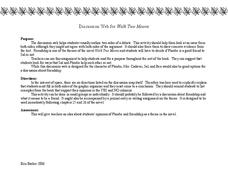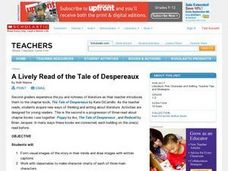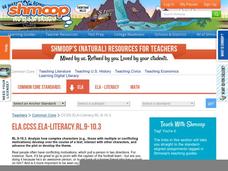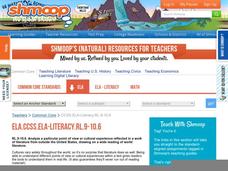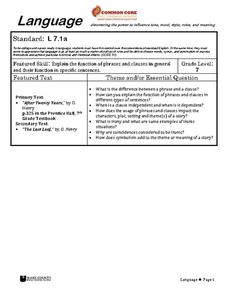Hawaiʻi State Department of Education
Characters from a Box
Character analysis is a skill we use when we read literary works or want to write a good story. Learners will use drama to practice character analysis while focusing on the details that make characters act the way they do. They'll each...
Curated OER
How Characters Get What They Want
Sixth graders analyze the primary force that drives a character's actions in a character analysis lesson. In this character analysis lesson, 6th graders analyze how characters present their actions and participate in a group activity...
Curated OER
Learning to Analyze Characters
Learners discover writing strategies authors use to enhance characters. In this character writing lesson, students are read the Knuffle Bunny books by Mo Willems and analyze the story, characters and settings as they listen....
Curated OER
Analyzing Poetry and Characters
Students investigate historical context by reading poetry. In this language arts lesson plan, students discover the work of Michael Longley and examine his poem "Ceasefire." Students identify the sonnets used in the piece and...
Curated OER
Characters in Nathaniel Hawthorne's Stories
Learners read literature by Nathaniel Hawthorne and write an essay comparing the main characters in the two stories. In this character analysis lesson, students read the stories Young Goodman Brown and The Minister's Black Veil. Learners...
Curriculum Corner
Fiction Graphic Organizers
Analyze a fictional text with a four-page packet that explores a story's main character and moral, challenges scholars to ask and answer questions about the text, and to create a story map.
Curated OER
Analyzing Relationships
Students explore relationships between story characters. In this story elements and reading comprehension lesson plan, students generate character traits of the characters in Bridge to Terabithia, by Katherine Paterson. Students describe...
Prestwick House
The Scarlet Letter
A is for. . .? Readers test their recall of Nathaniel Hawthorne's The Scarlet Letter by filling in the blanks with words missing from a line of text and by identifying characters and events a crossword puzzle based on the novel.
Curated OER
Breaking Down Books
Learners practice their reading comprehension by analyzing and discussing books with their classmates. They record their responses to comprehension, evaluation, and interpretation questions provided on a worksheet that is referenced but...
Curated OER
Walk Two Moons: Discussion Web
Is Phoebe a good friend to Sal or not? After reading chapters twenty-five and twenty-six of Walk Two Moons, class members use the provided graphic organizer to develop an argumentative piece. Writers must decide if the two...
Curated OER
Character Cluster
Third graders practice identifying characters and story elements by creating a character cluster in class. In this story analysis lesson, 3rd graders discuss the story Snow White and identify the characteristics of the evil witch....
Curated OER
Reading Comprehension
In this reading comprehension lesson, 3rd graders read the story Treasury of Literature and complete various comprehension activities. Students answer factual questions about the story, analyze the story using a bubble map, and...
Curated OER
Imagine That! Analyzing Imagery
Poems by O. Henry, Marion Dane Bauer, Monty Roberts, and Langston Hughes provide the text for a study of symbolism, hyperbole, and imagery. Employing the “think-pair-share” strategy learners generate definitions of these terms and locate...
Curated OER
Character Attributes in Writing
Third graders analyze the importance of characters in fiction writing and performances. In this theatre lesson, 3rd graders identify the important characteristics of a fictional character and how to portray a character through many...
Curated OER
Lively Read of the Tale of Despereaux
Learners create a character map of the main characters in The Tale of Despereaux. After reading the text, students create a character chart based on information they gleaned from the story. They use this information to write a letter...
Smithsonian Institution
Mobilizing Children
Scholars find out how the government used propaganda to mobilize children to help in the war effort. Lesson exercises include analyzing a quote from Franklin Roosevelt, viewing propaganda images and posters, and participating in a lively...
Federal Reserve Bank
Your Budget Plan
What do Whoosh and Jet Stream have in common? They are both characters in a fantastic game designed to help students identify various positive and negative spending behaviors. Through an engaging activity, worksheets, and...
Curriculum Corner
Native American Literature
Celebrate and honor Native American culture with this set of graphic organizers that showcases literature like The Girl Who Loved Wild Horses and A Boy Called Slow as well as three other Native American literature books....
Curated OER
Moby Dick Puppetry
Such an ambitious lesson! Third graders with special needs listen to an audio recording of the novel, Moby Dick. They stop often to discuss each of the main characters and analyze their actions in the story. They then make puppets of one...
Shmoop
ELA.CCSS.ELA-Literacy.RL.9-10.3
Focus on complex characters with a lesson from a series that teaches individual skills from the Common Core. Specifically, this resource provides practice with standard RL.9-10.3. Get pupils thinking and talking about characters with the...
Shmoop
ELA.CCSS.ELA-Literacy.RL.9-10.9
As the saying goes: there are no new stories. Standard 9 for reading literature in the Common Core addresses this fact and requires that students be able to analyze how authors use the themes, stories, and characters of earlier works....
Shmoop
ELA.CCSS.ELA-Literacy.RL.9-10.6
Being able to identify and understand the point of view of fictional characters across a wide range of time periods, places, and cultures is a skill that is necessary for becoming a proficient reader. It is also a skill identified in the...
Scholastic
Persausive Writing
A unit on persuasive writing guides elementary learners through the writing process. The first part examines the elements of persuasive writing, including expressing an opinion, connecting ideas, using supporting facts, and writing...
Wake County Public Schools
Language
Have your class doing everything from reading literature, analyzing literary devices, identifying independent and dependent clauses, discussing, and writing creatively with the rich resource found here. After a mini lesson on independent...
Other popular searches
- Analyzing Characters Mystery
- Analyzing Characters Notes
- Analyzing Characters Buck
- Analyzing Characters Paper









